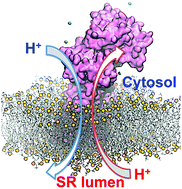The Ca2+-ATPase pump facilitates bidirectional proton transport across the sarco/endoplasmic reticulum
Abstract
Ca2+ transport across the sarco/endoplasmic reticulum (SR) plays an essential role in intracellular Ca2+ homeostasis, signalling, cell differentiation and muscle contractility. During SR Ca2+ uptake and release, proton fluxes are required to balance the charge deficit generated by the exchange of Ca2+ and other ions across the SR. During Ca2+ uptake by the SR Ca2+-ATPase (SERCA), two protons are countertransported from the SR lumen to the cytosol, thus partially compensating for the charge moved by Ca2+ transport. Studies have shown that protons are also transported from the cytosol to the lumen during Ca2+ release, but a transporter that facilitates proton transport into the SR lumen has not been described. In this article we propose that SERCA forms pores that facilitate bidirectional proton transport across the SR. We describe the location and structure of water-filled pores in SERCA that form cytosolic and luminal pathways for protons to cross the SR membrane. Based on this structural information, we suggest mechanistic models for proton translocation to the cytosol during active Ca2+ transport, and into the SR lumen during SERCA inhibition by endogenous regulatory proteins. Finally, we discuss the physiological consequences of SERCA-mediated bidirectional proton transport across the SR membrane of muscle and non-muscle cells.



 Please wait while we load your content...
Please wait while we load your content...